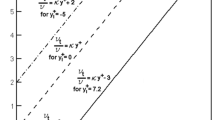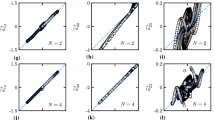Abstract
Prediction of the characteristics of turbulent flows with strong streamline curvature, such as flows in turbomachines, curved channel flows, flows around airfoils and buildings, is of great importance in engineering applications and poses a very practical challenge for turbulence modeling. In this paper, we analyze qualitatively the curvature effects on the structure of turbulence and conduct numerical simulations of a turbulent U-duct flow with a number of turbulence models in order to assess their overall performance. The models evaluated in this work are some typical linear eddy viscosity turbulence models, nonlinear eddy viscosity turbulence models (NLEVM) (quadratic and cubic), a quadratic explicit algebraic stress model (EASM) and a Reynolds stress model (RSM) developed based on the second-moment closure. Our numerical results show that a cubic NLEVM that performs considerably well in other benchmark turbulent flows, such as the Craft, Launder and Suga model and the Huang and Ma model, is able to capture the major features of the highly curved turbulent U-duct flow, including the damping of turbulence near the convex wall, the enhancement of turbulence near the concave wall, and the subsequent turbulent flow separation. The predictions of the cubic models are quite close to that of the RSM, in relatively good agreement with the experimental data, which suggests that these models may be employed to simulate the turbulent curved flows in engineering applications.
Similar content being viewed by others
References
Bradshaw P. Effects of streamline curvature on turbulent flow[R]. Agardograph No 169, AGARD, 1973.
Durst F, Rastogi A K. Turbulent shear flows 2[M]. Berlin: Springer, 1980.
Qian W Q, Fu S. Curvature sensitive nonlinear turbulence model[J]. Acta Aerodynamica Sinica, 2001, 19(2):203–209 (in Chinese).
Rumsey C L, Gatski T B, Morrison J H. Turbulence model predictions of strong curved flow in a U-duct[J]. AIAA J, 2000, 38(8):1394–1402.
Huang Y N, Ma H Y. Reynolds stress model involving the mean spin tensor[J]. Physical Review, E, 2004, 70:036302.1-10. DOI: 10.1103/PhysRevE. 70. 036302
Craft T J, Launder B E, Suga K. Development and application of a cubic eddy-viscosity model of turbulence[J]. International Journal of Heat and Fluid Flow, 1996, 17(2):108–115.
Yang X D, Ma H Y, Huang Y N. Prediction of homogeneous shear flow and a back ward-facing step flow with some linear and non-linear κ-ε turbulence models[J]. Communications in Nonlinear Science and Numerical Simulation, 2005, 10(3):315–328.
Huang Y N, Ma H Y, Chu H J. Modelling turbulent swirling flows based on the algebraic two-equation approach[J]. International Journal for Numerical Methods in Fluids, 2006, 51(3):285–304.
Ma Huiyang, Huang Yuning, Xu Jinglei. Applications of nonlinear eddy-viscosity models in noninertial system[C]. In: The 13th National CFD Conference, 2007, 345–351 (in Chinese).
Zhang H S, So R M C, Gatski T B, et al. A near-wall second-order closure for compressible turbulent flows near-wall turbulent flows[C]. In: So R M C, Speziale C G, Launder B E (eds). Near-Wall Turbulent Flows. Elsevies Science Publishers B V, 1993, 209–218.
Speziale C G, Abid R, Anderson C. Critical evaluation of two-equation models for near-wall turbulence[J]. AIAA J, 1992, 30(2):324–331.
Zhang H S, So RMC, Speziale C G, et al. Near-wall two-equation model for compressible turbulent flows[J]. AIAA J, 1992, 31(1):196–199.
Shih T H, Zhu J, Lumley J L. A realizable Reynolds stress algebraic equation model[R]. NASA TM 105993, 1993.
Abid R, Morrison J H, Gatski T B, et al. Prediction of aerodynamic flows with a new explicit algebraic stress model[J]. AIAA J, 1996, 34(12):2632–2635.
Monson D J, Lee Seegmiller H. An experimental investigation of subsonic flow in a two-dimensional U-duct[R]. NASA Technical Memorandum 103931.
Monson D J, Seegmiller H L, McConnaughey P K, et al. Comparison of experiment with calculations using curvature-corrected zero and two equation turbulence models for a two-dimensional U-duct[R]. AIAA 1990, 90–1484.
LUO Jiang, Lakshminarayana Budugur. Prediction of strongly curved turbulent duct flow with Reynolds stress model[J]. AIAA J, 1997, 35(1):91–98.
Author information
Authors and Affiliations
Corresponding author
Additional information
Communicated by ZHOU Zhe-wei
Rights and permissions
About this article
Cite this article
Xu, Jl., Ma, Hy. & Yu-ning, H. Nonlinear turbulence models for predicting strong curvature effects. Appl. Math. Mech.-Engl. Ed. 29, 31–42 (2008). https://doi.org/10.1007/s10483-008-0105-z
Received:
Issue Date:
DOI: https://doi.org/10.1007/s10483-008-0105-z




